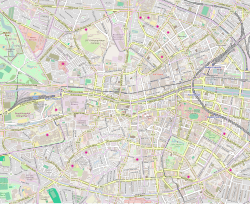The Scots Presbyterian Church is a ruined former church on Seán McDermott Street (formerly Gloucester Street North or Gloucester Street Lower) in Dublin 1, Ireland. The church was designed in a Greek revival style by architect Duncan Campbell Ferguson and completed in 1846 at a cost of £1,800.[1][2]
| Scots Presbyterian Church, Dublin | |
|---|---|
| Duke of Gloucester Chapel | |
 | |
| 53°21′15″N 6°15′02″W / 53.354056°N 6.250618°W | |
| Location | 62 Seán McDermott Street, County Dublin |
| Country | Ireland |
| Denomination | Presbyterian |
| History | |
| Founded | 1846 |
| Architecture | |
| Architect(s) | Duncan Campbell Ferguson |
| Architectural type | Church |
| Style | Greek revival |
The building operated as a Presbyterian church from 1846 until 1888 when the congregation was subsumed by the nearby Clontarf and Scots Presbyterian Church.[3][4] The building continued to operate as a sometime church for various services until 1896, at which point the building began being used by the Salvation Army owing to its position in the centre of the Monto area of Dublin. In the early 1900s it was converted into a flour mill but its external appearance remained largely intact. It was operated by AW Ennis Limited until a fire in the 1980s forced the business to move to Virginia, County Cavan where it remains as of July 2020.[5][6] It was subsequently used as a grain store.[7]
History
editThe church replaced an earlier Ebenezer Chapel (which was established in 1820 as an independent chapel) which the second secession synod congregation had purchased on the corner of Hawkins Street and D'Olier Street, Dublin 2 in 1836 for £600.[8][9]
The Scots Church and Ormond Quay Presbyterian church amalgamated in 1938, with the Ormond Quay congregation joining the Scots congregation.
In 2003, the Ormond Quay and Scots Church voted to merge with the Clontarf Presbyterian Church, sanctioned by the General Assembly to create the Clontarf & Scots Presbyterian Church, and they moved to Clontarf, Dublin.
Architecture
editThe squat church was constructed in Irish granite with a prostyle tetrastyle pedimented portico with four fluted Doric columns on a stylobate supporting frieze with Greek script which have the words "ΜΟΝΩ ΣΟΦΩ ΘΕΩ ΣΩΤΗΡI ΗΜΩΝ ΔOΞA" (Romanized monō sophō Theō sōtēri hēmōn doxa), referring to a biblical passage from Jude 1:25 and translating roughly as "To only-wise God, be glory through [the] savior".[10] Above this sits a modillioned pediment with acroteria situated at either end and at the apex.[11]
The majority of the external features remained intact until the 1980s with a Dublin City Council photo from 1968 detailing the external walls, chimneys and roof as they would have been when the building was first constructed.[12][13] Following the fire, the majority of the building was demolished for safety reasons.[14] The remaining facade and side walls now sit at the front of 2000s apartment development although many of the main features are still intact.[15]
The buildings risk status is currently listed as at 'moderate' by An Taisce and is currently listed on the Record of Protected Structures under RPS 7480.[16][17]
Popular culture
editThe building appears in a derelict state on the front cover of the 1997 single Keep on Chewin by the Jubilee Allstars.[18]
See also
editReferences
edit- ^ "CO. DUBLIN, DUBLIN, GLOUCESTER STREET LOWER, PRESBYTERIAN CHURCH". Dictionary of Irish Architects 1720 - 1940. DIA. Retrieved 15 July 2020.
- ^ Christine Casey (2005). Dublin: The City Within the Grand and Royal Canals and the Circular Road with the Phoenix Park. Yale University Press. ISBN 0-300-10923-7.
- ^ "Clontarf Church 1835 to date". Clontarf Church. Retrieved 17 July 2020.
- ^ James Seaton Reid; William Dool Killen (1853). A History of the Presbyterian Church in Ireland: Comprising the Civil History of the Province of Ulster from the Accession of James the First ... [continued ... Whittaker.
- ^ Jimmy Wren (1993). Crinan - Dublin: A History of 13 North Inner City Streets. North Inner City Folklore Project. ISBN 978-1-898479-00-0.
- ^ "A forgotten building on Sean MacDermott Street". Come Here to Me. Retrieved 17 July 2020.
- ^ An Irishman's Diary Irish Times. January 6, 2006.
- ^ Comerford, Patrick. "VHI brings new life to former Scots Presbyterian Church on Abbey Street, Dublin". www.patrickcomerford.com. Retrieved 29 July 2020.
- ^ George Newenham Wright (1825). An Historical Guide to the City of Dublin, Illustrated by Engravings, and a Plan of the City. Baldwin, Cradock, and Joy. p. 100.
- ^ "Sean McDermott Street, Dublin, Dublin City". National Inventory of Architectural Heritage. Retrieved 17 July 2020.
- ^ Curran, Constantine Peter (1830). "Duke of Gloucester Chapel, Sean MacDermott Street: façade". Retrieved 7 October 2021.
- ^ "GD111 Rutland Street National School, Rutland Street Lower area, Sean Macdermott Street Lower, 1968". Dublin City Council. Retrieved 17 July 2020.
- ^ "Former Scots Presbyterian Church, Lower Sean MacDermott Street, Dublin city (1952/1953)". RTE Stills Library. Retrieved 17 July 2020.
- ^ "Awaiting the Saviour". The Irish Aesthete. Retrieved 17 July 2020.
- ^ "Future of Sean McDermott scheme uncertain". Irish Times. Retrieved 17 July 2020.
- ^ "Church Fascade, Dublin 1". An Taisce. Retrieved 17 July 2020.
- ^ "Record of Protected Structures in Dublin City" (PDF). Dublin City Council. Retrieved 20 July 2020.
- ^ "Jubilee Allstars – Keep On Chewin'". discogs.com. Retrieved 20 July 2020.
